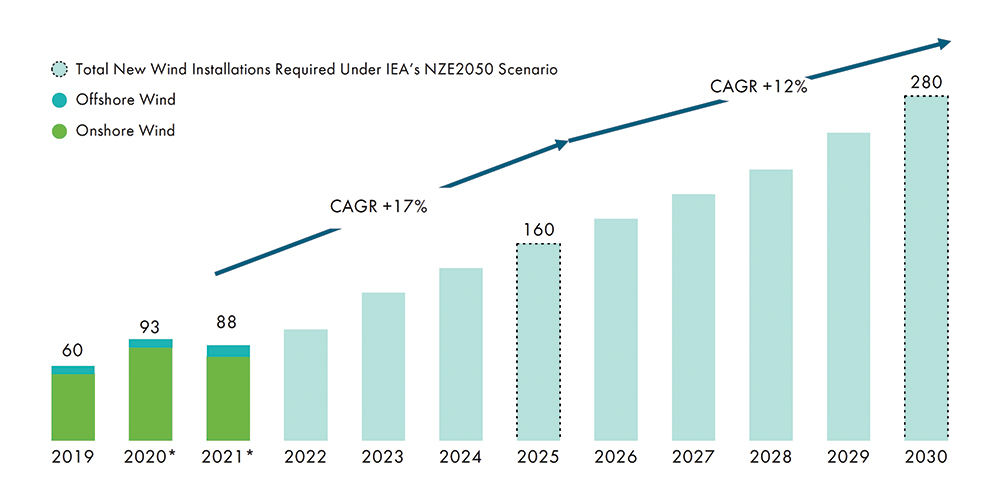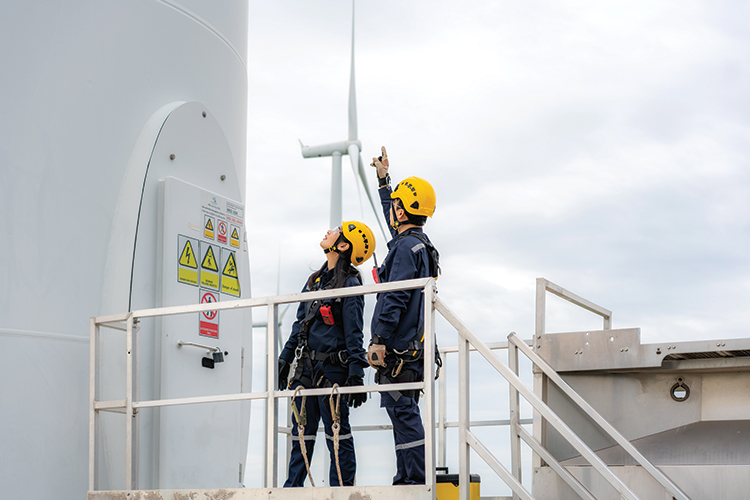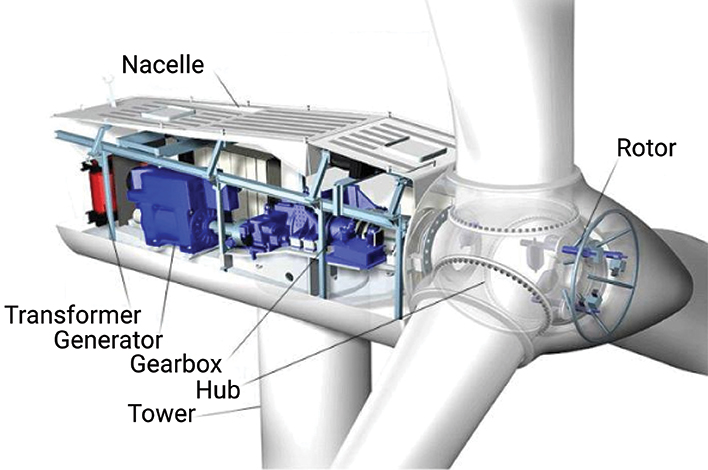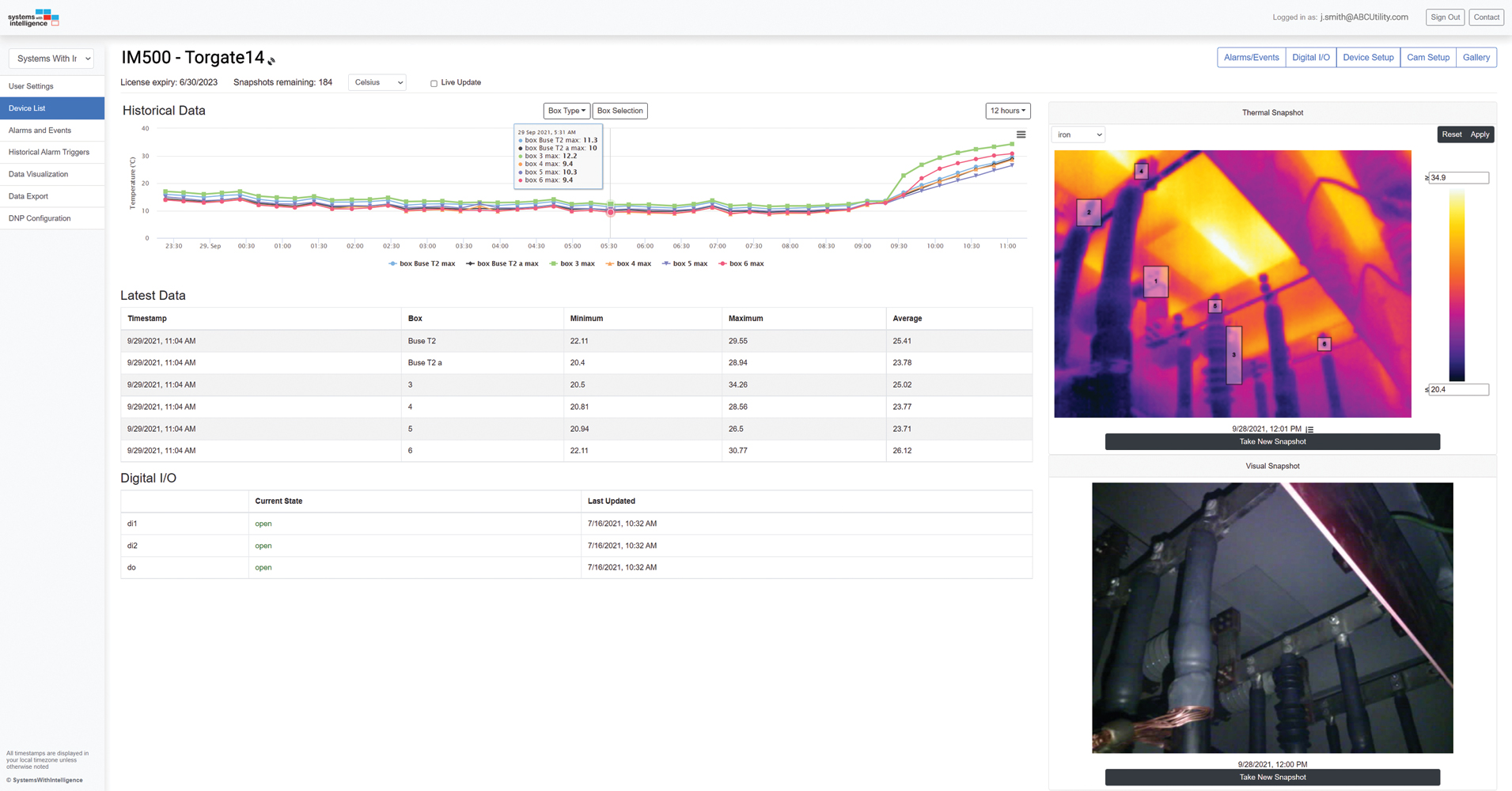The growth in wind energy
The number of wind farm installations has been growing steadily for the past several years with more and more countries pledging green generation and having goals to reach zero C02 emissions status. In 2020, there was more than 93 GW of new wind generation capacity installed, representing a growth of 53% over the previous year. [1] New installations are expected to continue to grow over the next several years, with growth in offshore windfarms predicted to gain momentum and increase in the percentage of wind generation.

Source: GWEC Market Intelligence; IEA World Energy Outlook (2020s)
As wind farms continue to be rolled out, the maintenance challenges will continue to grow as larger and more powerful turbines are deployed in more difficult-to-reach locations. Whereas an average wind turbine produces 2-3 MW, the newest, most powerful wind turbines stand more than 250 m tall, with 100 m long blades and produce 15 MW of power. With the growth of wind energy, the complexity of the technology and the criticality of maintaining reliable operation grows with it. The future of wind farms is changing from being an add-on to conventional power generation to being the primary source of power generation.
Maintenance challenges
As the percentage of power generation increases in wind power, the level of importance in maintaining these systems grows with it. The conventional methods of thermal power generation are decades old, and therefore, the reliability and maintenance methods for these generation systems has matured. Wind generation technology is relatively young, and there are new developments in wind technology happening regularly. Many of the conventional equipment concepts – such as generators, transformers and breakers – are used for wind applications but on a different scale, and to complicate things, these pieces of equipment are located in a moving nacelle, on a tower, 100m off the ground. The maintenance techniques for wind generation are new and evolving as the technology matures.
Wind turbine technicians
A wind turbine technician, or wind tech, installs, inspects, maintains, operates and repairs wind turbines. The demand for qualified wind turbine technicians is growing with the increasing number of installations; in 2016 it was the fastest-growing occupation of the decade, [2] with strong demand for the foreseeable future. The wind tech must be physically fit enough to climb inside the tower while carrying parts and tools and have no fear of heights or enclosed spaces. Most of the maintenance and inspection work is done inside the nacelle that houses the major equipment. The wind tech must be knowledgeable in many areas to maintain the mechanical and hydraulic equipment that controls the positioning system and gearbox as well as the electrical equipment such as the generator, transformer, breakers and switches. The specialized training that wind techs must receive also has a focus on safety and first aid.

Figure 1: Access to the nacelle requires special training and equipment.
Challenging locations
Wind farms are usually in remote locations requiring extra time and logistics to get to sites with the proper equipment. Offshore wind farms are even more challenging and require more planning, training and transportation to reach the site. Once at a wind farm, it takes additional time and physical exertion just to access the equipment inside the nacelle. Wind turbines inspections are much more complicated when compared to the inspection of land-based substation equipment. In the U.S., a medium-sized wind farm will have 50 – 100 turbines per site so it can take days or weeks to inspect each turbine manually. In addition, the wind turbines are shut down during the inspection so electrical issues that occur under load will not be detected during a manual inspection.
With the knowledge that maintaining the equipment inside the wind turbine is labor-intensive and physically challenging, wind farm operators are recognizing the value of online condition monitoring. [3] Through automated and early detection of faults, more serious failures can be prevented through condition-based maintenance that allows operators to optimize resources and reduce repair costs. There are several condition monitoring systems for wind turbines to monitor both electrical and mechanical systems that operators can consider for their site. Many of these systems will be turning to new technology to help reduce the number of manual inspections.
Technology to overcome challenges
Energy 4.0 technology will help with maintenance and inspections
Some utilities have started to implement in their operations, the same emerging technologies that are driving the fourth industrial revolution in the manufacturing sector. The Industrial Internet of Things, (IIoT), machine learning and cloud computing are among the new technologies that are already being used by a few electric companies around the globe for asset monitoring [3] predictive maintenance [4] and the operations of distributed energy resources (DER) [5]. Some industry experts have started calling this trend Energy 4.0 to highlight the magnitude of the transformation they expect it will bring to the electric industry.
Emerging technologies like the Industrial Internet of Things (IIoT), Artificial Intelligence (AI), machine learning, cloud computing, etc. can provide the tools utilities need to adapt to this new industry environment and provide arguments in favor of full adoption of these technologies by the electric industry [3]. These emerging technologies are part of what now is known as the fourth industrial revolution, or Industry 4.0, which is why some people refer to the use of these technologies in the electric industry as Energy 4.0.
Monitoring the wind turbine with thermal imaging
Thermal imaging sensors can measure the infrared radiation from an object and convert it into a temperature value. An important feature of thermal imaging is that it is 'non-invasive,' it uses a sensor that can measure temperature values without physically touching the object; therefore, it is not required to power down equipment to install the sensor or to make the temperature measurements.
Thermal imaging measures and detects overheating in any electrical component that has current running through it. Thermal imaging is commonly used in electrical applications to detect faults in connection points, switches, bushings, transformers, generators and motors. If there is current flowing through a path with resistance it will cause heat to be generated that will be detected by the thermal sensor. Thermal sensors can also detect excessive heat due to friction in the bearings of the generator, gearbox or motors that control the positioning of the turbine components.

Figure 2: Electrical and mechanical systems inside the nacelle can be monitored with infrared sensors.
A typical thermal sensor has a field of view allowing it to capture a scene with multiple areas of interest in it. As an example, the sensor may be able to view the whole transformer and its bushings and connection points. The sensor can then pick out the areas of interest within the scene and capture the temperature values and store them as data points. Some thermal sensors are mounted on a pan and tilt base that allows them to cycle through a series of different views and areas of interest. An advantage of thermal imaging is that a single sensor can monitor a variety of different pieces of equipment instead of having separate, specialized sensors for each. Thermal asset monitoring can be used to track temperature fluctuation over the course of the day, week and seasonally to monitor if there is a trend in the asset temperature that could be an indicator of an impending problem.
Portable infrared cameras have been typically used by thermographers in the electric power industry to periodically inspect substations and other key areas of the grid. While periodic scanning is useful, automated and continuous thermal monitoring has many advantages such as being able to provide measurements during changing environmental and load conditions, as well as being able to provide the data directly to operators, SCADA, and asset management systems.
With the advancement of IoT and infrared technology, the two are now able to be combined into a single sensor. This brings thermal imaging into the IoT world and makes the technology and associated data much more accessible and cost-effective.
Practical application
In this application, the wind farm operator wanted an online monitoring system that could detect faults to allow them to schedule maintenance before more serious problems developed. Time-based maintenance was often performed on healthy systems and was costing the operator valuable resources that could be deployed for more urgent issues. The operator was familiar with infrared technology and how it could be used to detect potential problems in electrical systems. Infrared sensors detect the excess heat emitted through arcing in failing insulation or poor electrical connections. Infrared technology is a proven technology that has long been used by utilities for inspections of transformers, busbars, breakers, switches and other primary and secondary substation equipment.
The solution
The device used was an IoT sensor with onboard thermal and visual imagers and built-in wireless communications. The sensor takes temperature readings on live systems and will detect overheating bushings, cables, joints and insulators – even in enclosed and confined spaces. Due to its small size and low power requirement, the sensor can be installed quickly using high-powered magnetic mounts to keep the unit in place.
The sensors are pre-programmed to take snapshots that give operators a visual and thermal view of the system. The thermal data is collected, stored, and analyzed continuously. The cloud-based dashboard provides a comprehensive view of the data with graphs of the temperature points along with visual and thermal images. Alarm thresholds can be set in the dashboard, so operators are alerted instantly if pre-set temperatures are exceeded. The data and alarms can be sent to SCADA or PI systems through an IoT Sensor Gateway, allowing the utility to trend the data and use it in a condition-based maintenance program.

Figure 3: Comprehensive dashboard provides status, trending and visualization information
(click to enlarge)
Summary
Using IoT and thermal sensing technology will allow wind farm operators to perform remote inspections, with 24/7 monitoring on sites and equipment that would otherwise be difficult, costly and time-consuming to inspect. The sensors provide visual and thermal imaging of equipment inside the nacelle without having to send personnel to the site. The IoT sensors can be installed quickly and easily due to their small and lightweight form factor, low voltage requirements and built-in communications. Temperature data is sent to SCADA or PI applications for further analysis, trending and input to asset management applications. Continuous thermal monitoring ultimately improves safety and reliability while reducing operating costs.
 Richard Harada has more than 20 years of experience in industrial networking communications and applications. Prior to joining Systems With Intelligence, Harada worked at Rugged.Com and Siemens Canada, where he focused on product management and business development for industrial communications in the electric power market. Harada is an electronic engineering technologist with a Bachelor of Science degree in computer science from York University in Toronto.
Richard Harada has more than 20 years of experience in industrial networking communications and applications. Prior to joining Systems With Intelligence, Harada worked at Rugged.Com and Siemens Canada, where he focused on product management and business development for industrial communications in the electric power market. Harada is an electronic engineering technologist with a Bachelor of Science degree in computer science from York University in Toronto.
References
[1] Global Wind Energy Council – Global Wind Report 2021.
[2] https://www.energy.gov/eere/articles/everything-you-need-know-about-wind-turbine-technicians.
[3] M. Rebolini, A. Valant and F. Pepe, "Terna's approach for on-line monitoring system Intelligent management of Assets in a large scale infrastructures," in AEIT International Annual Conference (AEIT), Cagliari, ITALY, 2017.
[4] ECG, Inc., "TEPCO to Implement ECG's Predict-It™ Analytics Solution," 24 04 2019. [Online]. Available: https://www.prnewswire.com/news-releases/tepco-to-implement-ecgs-predict-it-analytics-solution-300836700.html.
[5] P. Darrell, "Innovative Microgrid Will Power Finnish Distribution Center," 01 01 2019. [Online]. Available: https://www.powermag.com/innovative-microgrid-will-power-finnish-distribution-center/.






